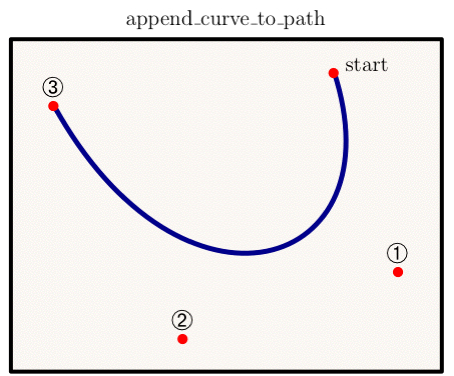Creating Paths
These are the general methods for creating paths for later use in PDF graphics operations.
FigureMaker methods
append_curve_to_path(x1, y1, x2, y2, x3, y3, _skip_log_check=False) [ doc | example ]
Append a cubic Bezier curve to the current path. The curve extends from the current path end to the point given by the figure coordinates (`x3`, `y3`), using (`x1`, `y1`) and (`x2`, `y2`) as the Bezier control points (also in figure coordinates). The new path end is (`x3`, `y3`). See also `bezier_control_points()`.
Example
The illustration shows in dark blue the curve that is added for the control points given in red.

append_point_to_path(x, y, _skip_log_check=False) [ doc ]
Append a straight line segment from the current path end to the point given by the figure coordinates (`x`, `y`). The new path end point is (`x`, `y`).
append_points_to_path(x, y, _skip_log_check=False) [ doc ]
The arguments `x` and `y` should be arrays of equal lengths holding figure coordinates for points. If there is an open subpath already under construction, the first point is added with `append_point_to_path()`, but if the path is empty or has just been closed, then the first point is passed to `move_to_point()` instead. All subsequent points are used for calls to `append_point_to_path()`.
append_points_with_gaps_to_path(x, y, gap, close_subpath=False, _skip_log_check=False) [ doc ]
Like `append_points_to_path()`, but where there is a gap, it does `move_to_point()` instead of `append_point_to_path()`. If the flag `close_subpath` is True, then does `close_path()` before doing the `move_to_point()` for each gap. The array `gap` holds integer indices in `x` and `y` for locations that should be moved to. This routine is useful with sources that provide paths that may consist of many subpaths (such as `make_contour()`).
close_path() [ doc ]
Closing a path has the effect of adding a line from the end of the current subpath to the start of that subpath as determined by the previous `move_to_point()`. Typically, the last action for a closed path should be a call to `close_path()` so that the line join will be done properly at the junction point; see `stroke()` for details.
discard_path() [ doc ]
Reset the path to empty. This is done automatically after each `stroke()`, `fill()`, or `clip()`.
move_to_point(x, y, _skip_log_check=False) [ doc ]
Begin a new subpath by moving to the point given by the figure coordinates (`x`, `y`), omitting any connecting line segment. If the previous path construction operator in the current path was also `move_to_point()`, the new `move_to_point()` overrides it; no vestige of the previous `move_to_point()` operation remains in the path. Note that once you start a path, you must finish with it before going on to anything else. So you need to do a sequence of path producer operations followed by a single path consumer operation. After the path consumer operation finishes, the current path is reset to empty and you can then safely do other operations such as change the line width or the line type.
update_bbox(x, y) [ doc ]
Adds the figure coordinates point (`x`, `y`) to the bounding box. Not usually needed, but can be helpful with text that is outside the box determined by the graphics since the Tioga kernel does not have exact information about how large the text bbox will be once TeX has done the typesetting.
FigureMaker attributes
croak_on_nonok_numbers [ doc ]
If `self.croak_on_nonok_numbers` is set, the kernel will emit a warning when it encounters a weird point (such as with infinite or NaN coordinates) in a primitive path operation. In any case, the faulty element in the path will be discarded.
PyTioga version: alpha (20071021)
Copyright (C) 2007 Taro Sato & Bill Paxton. All rights reserved.